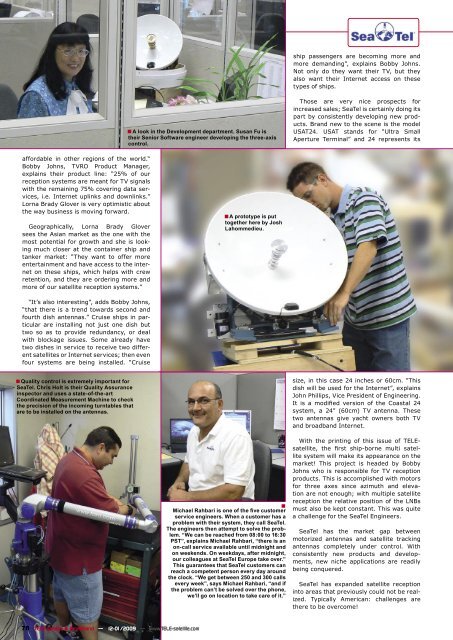_default _116_pages.indd - TELE-satellite International Magazine
_default _116_pages.indd - TELE-satellite International Magazine
_default _116_pages.indd - TELE-satellite International Magazine
You also want an ePaper? Increase the reach of your titles
YUMPU automatically turns print PDFs into web optimized ePapers that Google loves.
■<br />
78 <strong>TELE</strong>-<strong>satellite</strong> & Broadband — 12-01/2009 — www.<strong>TELE</strong>-<strong>satellite</strong>.com<br />
■<br />
affordable in other regions of the world.“<br />
Bobby Johns, TVRO Product Manager,<br />
explains their product line: “25% of our<br />
reception systems are meant for TV signals<br />
with the remaining 75% covering data services,<br />
i.e. Internet uplinks and downlinks.”<br />
Lorna Brady Glover is very optimistic about<br />
the way business is moving forward.<br />
Geographically, Lorna Brady Glover<br />
sees the Asian market as the one with the<br />
most potential for growth and she is looking<br />
much closer at the container ship and<br />
tanker market: “They want to offer more<br />
entertainment and have access to the internet<br />
on these ships, which helps with crew<br />
retention, and they are ordering more and<br />
more of our <strong>satellite</strong> reception systems.”<br />
“It’s also interesting”, adds Bobby Johns,<br />
“that there is a trend towards second and<br />
fourth dish antennas.” Cruise ships in particular<br />
are installing not just one dish but<br />
two so as to provide redundancy, or deal<br />
with blockage issues. Some already have<br />
two dishes in service to receive two different<br />
<strong>satellite</strong>s or Internet services; then even<br />
four systems are being installed. “Cruise<br />
Quality control is extremely important for<br />
SeaTel. Chris Holt is their Quality Assurance<br />
inspector and uses a state-of-the-art<br />
Coordinated Measurement Machine to check<br />
the precision of the incoming turntables that<br />
are to be installed on the antennas.<br />
A look in the Development department. Susan Fu is<br />
their Senior Software engineer developing the three-axis<br />
control.<br />
■<br />
A prototype is put<br />
together here by Josh<br />
Lahommedieu.<br />
Michael Rahbari is one of the five customer<br />
service engineers. When a customer has a<br />
problem with their system, they call SeaTel.<br />
The engineers then attempt to solve the problem.<br />
“We can be reached from 08:00 to 16:30<br />
PST”, explains Michael Rahbari, “there is an<br />
on-call service available until midnight and<br />
on weekends. On weekdays, after midnight,<br />
our colleagues at SeaTel Europe take over.”<br />
This guarantees that SeaTel customers can<br />
reach a competent person every day around<br />
the clock. “We get between 250 and 300 calls<br />
every week”, says Michael Rahbari, “and if<br />
the problem can’t be solved over the phone,<br />
we’ll go on location to take care of it.”<br />
■<br />
ship passengers are becoming more and<br />
more demanding”, explains Bobby Johns.<br />
Not only do they want their TV, but they<br />
also want their Internet access on these<br />
types of ships.<br />
Those are very nice prospects for<br />
increased sales; SeaTel is certainly doing its<br />
part by consistently developing new products.<br />
Brand new to the scene is the model<br />
USAT24. USAT stands for “Ultra Small<br />
Aperture Terminal” and 24 represents its<br />
size, in this case 24 inches or 60cm. “This<br />
dish will be used for the Internet”, explains<br />
John Phillips, Vice President of Engineering.<br />
It is a modified version of the Coastal 24<br />
system, a 24” (60cm) TV antenna. These<br />
two antennas give yacht owners both TV<br />
and broadband Internet.<br />
With the printing of this issue of <strong>TELE</strong><strong>satellite</strong>,<br />
the first ship-borne multi <strong>satellite</strong><br />
system will make its appearance on the<br />
market! This project is headed by Bobby<br />
Johns who is responsible for TV reception<br />
products. This is accomplished with motors<br />
for three axes since azimuth and elevation<br />
are not enough; with multiple <strong>satellite</strong><br />
reception the relative position of the LNBs<br />
must also be kept constant. This was quite<br />
a challenge for the SeaTel Engineers.<br />
SeaTel has the market gap between<br />
motorized antennas and <strong>satellite</strong> tracking<br />
antennas completely under control. With<br />
consistently new products and developments,<br />
new niche applications are readily<br />
being conquered.<br />
SeaTel has expanded <strong>satellite</strong> reception<br />
into areas that previously could not be realized.<br />
Typically American: challenges are<br />
there to be overcome!

















